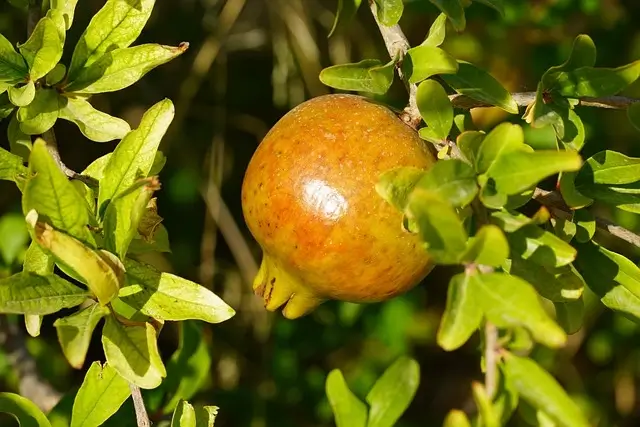Pomegranate cultivation is an important agricultural activity in India, and the country is among the leading producers of pomegranates in the world. The major pomegranate-producing states in India are Maharashtra, Karnataka, Andhra Pradesh, Gujarat, and Tamil Nadu.
The climate in India is ideal for pomegranate cultivation, as the fruit thrives in areas with hot summers and cool winters. Pomegranate trees are grown in both irrigated and rain-fed conditions, with the former being more common. The cultivation of pomegranates in India is mostly done on small farms, with an average landholding size of 1-2 hectares.
Pomegranate cultivation in India is done using both traditional and modern methods. Traditional methods involve planting trees in pits filled with farmyard manure and other organic materials, while modern methods involve the use of drip irrigation and fertigation. Pomegranate trees are also susceptible to several pests and diseases, so farmers use a range of techniques to manage these, including the use of pesticides, biocontrol agents, and cultural practices.
Guide to Pomegranate Cultivation
Climate
Pomegranates can grow in a range of climatic conditions, but they do best in areas with hot summers and cool winters. Pomegranate cultivation requires a warm, dry climate with hot summers and cool winters. They are adapted to a Mediterranean climate and prefer temperatures between 15-32°C (59-90°F). They are also drought-tolerant but require some irrigation during dry periods to ensure proper growth and fruit development.
Soil Type
Pomegranates can grow in a range of soil types, but they do best in well-draining soils that are rich in organic matter. The soil pH should be between 5.5 and 7.5, and the soil should have good fertility. Pomegranates can tolerate some soil salinity, but high levels can reduce plant growth and fruit quality.
Propagation of Pomegranates Plants
The development of another plant from the parent plant is called Propagation. It can be done through two methods seed propagation and the second is cutting propagation. Pomegranates can be propagated through both seeds and hardwood cutting methods. But they are commonly propagated through hardwood cuttings. If you do choose to propagate through seeds, sow the seeds in a well-draining soil mix, and keep them in a warm and bright location until they germinate. To propagate through hardwood cuttings, take cuttings about 8-12 inches long and plant them in a well-draining soil mix. Keep the soil moist but not waterlogged and place them in a bright location until they start to develop roots.
Commercial Pomegranate Varieties
Bhagwa, Wonderful, Hicaz, Eversweet, Red Silk, Angel Red, Ruby, Prfianka, and Mollar De Elche are a few varieties of pomegranate that are grown around the world. Each variety has its own unique flavor and characteristics, making them popular for a variety of uses, including eating fresh, juicing, and cooking. Bhagwa is the most popular variety of pomegranate in India, known for its sweet and juicy arils and bright red color. Mridula, Ganesh, Jyothi, Jalore Seedless, Kandhari, Phule Arakta, Phule Bhagwa Super, and Bhagwa Sindoor have commercially grown a variety of pomegranates grown in India.
Preparation of Land
Sol testing, clearing the land of weeds, and applying organic matter and fertilizers are some common steps for preparing the land. In the cultivation of pomegranates, beds, and rows are needed to prepare. Other land preparation is done through plowing, harrowing, and leveling.
Best Planting time
Planting of pomegranates is generally done in the spring season (February to march) in tropical regions. And in sub-tropical regions, it is done between July and August. Air layering is mostly done in the rainy season or between November to December.
Pomegranate Plant Spacing
In pomegranate planting, 5 to 6 m of spacing is maintained in northern India and the plains of the Deccan Plateau. High-density planting with a spacing of higher than 5 x 5 is adopted by some farmers that give a high yield.
Fertilizer Management
The dose of fertilizers should be incorporated according to the variety of soil fertility and region. Pomegranates are even grown in less fertile soil, but the recommended dose should be applied for better production and quality produce.
Irrigation
Pomegranate is a drought-tolerant crop that can grow in water scarcity to some extent. But regular irrigation is needed to avoid fruit splitting. Irrigation frequencies vary in different seasons. During winter irrigation should be done on a gap of 10 to 12 days whereas in summer it should be done in intervals of 4 to 5 days.
Training & Pruning
Training of plants in Pomegranate crops is done through both single and multi-step systems. Training is a promising method to control vegetative growth. It is also important for maintaining the shape and size of trees to enable proper light penetration and ease farming operations and harvesting. Pruning is not much required, only a little thinning and pruning of old spurs are required to encourage the growth of new plants.
Harvesting
Pomegranate harvesting is done after the flowers become ready as mature fruits. Flowers take 5 to 6 months to become mature in fruits. They should be harvested mature and recognized by their color for harvesting.
- Yield
A proper healthy pomegranate tree produces approx. 12 to 15 kg of plant yield in the first year. After one year the yield per plant will increase to 15 to 20 kg per plant.
Marketing
At a low production level marketing is possible on your own. But on the commercial level of marketing the need of an agent or broker is needed for marketing.
Conclusion
The fruit is used in a variety of ways, including as fresh fruit, juice, and concentrate, and in food products such as jams, jellies, and desserts. The pomegranate industry in India is growing rapidly, with demand increasing both domestically and internationally. The Indian government has also introduced various schemes and initiatives to support pomegranate cultivation, including the National Horticulture Mission and the Pradhan Mantri Fasal Bima Yojana.


Really nice.
Can I plant pomegranets in botswana